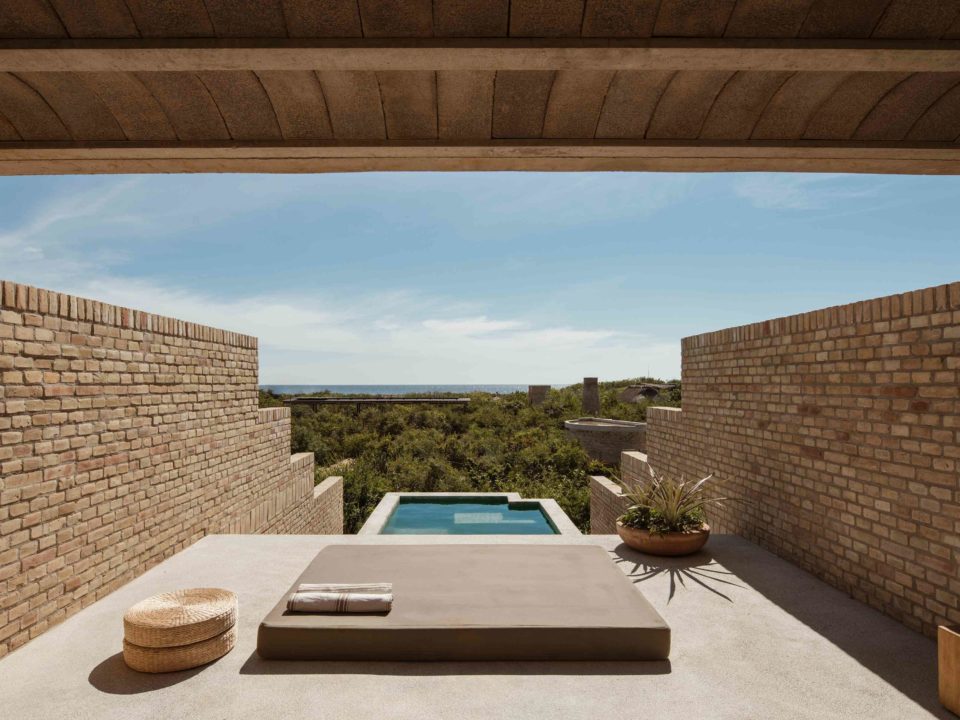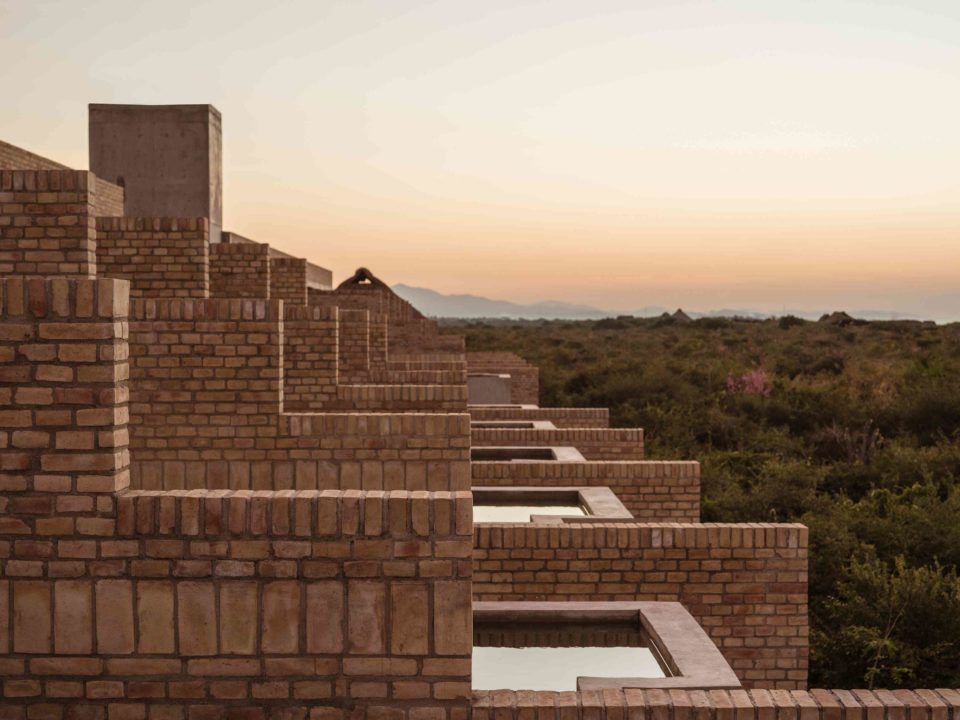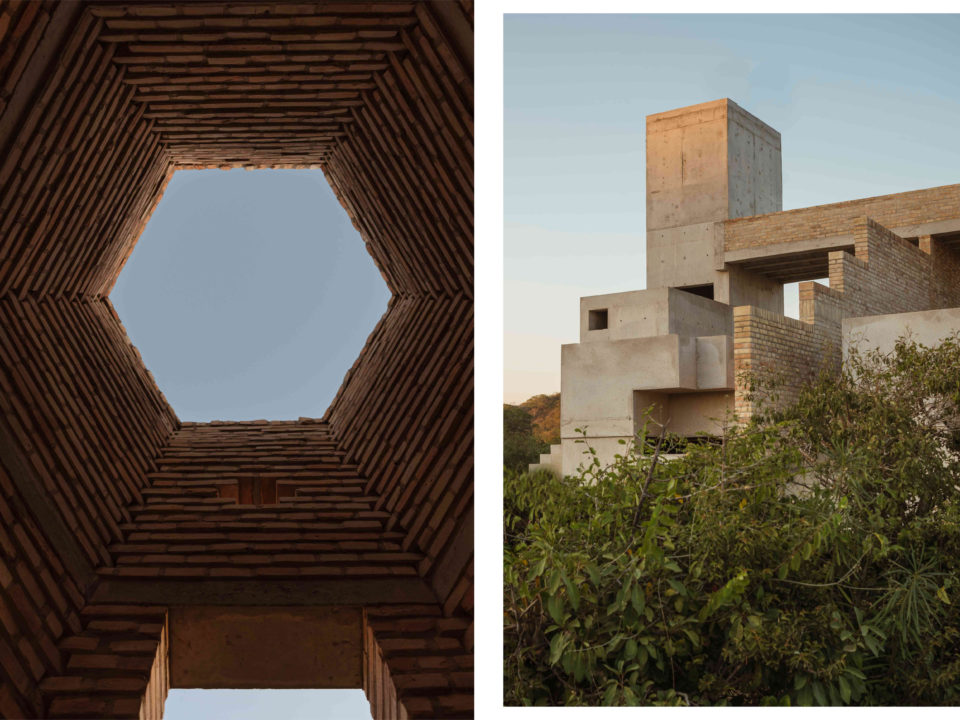Expectant visitors on the road to hotel Terrestre would be forgiven for thinking that they were on their way to a Sergio Leone film set. Mrs Smith and I looked a mess upon arrival, dishevelled by the drive, circled by vultures, and weary from cancelled flights.
We were the antithesis of the cool, sand-underfoot reception desk staffed by the affable Patrick. We looked at each other excitedly, needlessly whispering travel-worn phrases such as ‘this looks nice’, ‘look at that pool’, ‘different, isn’t it?’.
The source of our contained British thrill was the design of Terrestre. It is as if a series of modernist sculptures have landed, yet somehow aren’t out of place. Sand-hued hexagonal towers rise above the beautiful cactus garden, and a long V-shaped pool can be glimpsed around the turn of a sandy path.
The restaurant looks like a linear temple with a roof platform for the Instagram-inclined. Towards the skyline we can see the private villas where one guest idles in a hammock and another in their private pool. All of this would have to wait as we were punctual to the point of arriving four hours prior check-in.
Despite his word-perfect English, Patrick humoured my A-level Spanish, which he would come to learn only improved with mezcal and directed us to the beach bar. ‘Follow the disco balls’, Patrick said.
We would come to follow his suggestions blindly. The beach bar is spare and unassuming on a wild and empty stretch of the Oaxacan coastline. The deep sandy beach stretches along the coast, sculpted by the mighty Pacific, whose waves become the soundtrack to our stay. There are a few double-loungers for Terrestre guests, and with barely a soul on the beach, we relax into the rugged isolation. We almost forget that we have to check into our room.
But ‘room’ isn’t the correct term. The villas, designed by architect Alberto Kalach for Grupo Habita, are spectacular. The aesthetic is soft brutalism, with the exposed concrete offset by minimal wood furnishings and mute colours. We spend the next few hours lounging around and feeling very lucky.
Both levels look out onto the hinterland of deciduous forest and sierra. The vast bed faces them on the first level and then above a hammock and double lounger for the broader panorama of a sky occupied by vultures and hawks.
After some amateur twitching, we cool off in our plunge pool overlooking the gardens. We wander over to the restaurant at dusk, where the vivid sunset colludes spectacularly with the sandy pink of the hotel’s geometric shapes. Ice cold mezcalitos served in copper flagons admittedly heighten the atmosphere.
Mornings here are particularly special. Push open the handmade shutters and watch the hummingbirds flit between the flowers from your bed. It feels like you are in a relaxing sound installation in the early hours as the Pacific waves intermingle with the birdsong. I had been reading about Oaxaca’s spectacular diversity of flora and bird species in Oliver Sacks’s Oaxaca Journal, and here it was.
After breakfast on the second day, we went to the hammam housed within the brick towers. Getting in a steam room feels counterintuitive in April, Oaxaca’s hottest and most humid month, but rotating between the echoey chambers of pools and showers felt restorative. After the hammam, we went to the restaurant for some delicious fish tacos. Patrick told us that we should visit the mezcaleria next door, and after an afternoon of swimming and reading, we decided to take his advice.
The mezcaleria is right outside the hotel, and upon approaching it, you can feel a little intimidated. The bar looks as much like an open-air chemistry set as it does a drinking emporium. Giant boiling flasks full of mezcal sit behind the counter, and my Spanish withered in the face of the handsome and rugged proprietor as he described the flavours of each mezcal to us.
Not understanding a word and sweating profusely, I chose vintages at random, and we got down to drinking our large measures of the now famous firewater. Our amateur palates couldn’t distinguish the different terroir in the mezcals, but we could appreciate how delicious and dangerous this Mexican moonshine is.
The disco balls came into their own as we made our way back through the cactus garden to the restaurant. And for some unknown reason, the restaurant’s incredible food tasted particularly good that evening. Corn soup with stringy and salty Oaxacan cheese was followed by red snapper crudo tostada.
We woke early on our final morning, our hallucinatory jet-lag dreams being carried off by the sound of booming waves and madcap birdsong, all without a peyote plant in sight. I decided to shake off the mezcal rust by doing a few pool lengths and was treated to the morning haze before it was evaporated by the sun.
It all feels how luxury travel should. Instead of a derivative building that has been dropped somewhere beautiful, Terrestre feels intimate and very much of the place.
We leave wanting to explore Oaxaca and head into the hinterland. Or, as Oliver Sacks put it, ‘I will brood on the experience, I will read more. And I will surely come again.’
Got the taste for mezcal? We’ve got plenty more Mexico hotels…
Samuel Hunt is a journalist and filmmaker whose work has appeared in The Economist and on the BBC, Vice and Channel 4.






